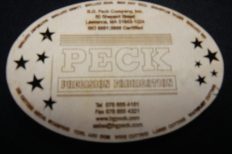

All About Lasers
Laser Cutting Manufacturing Processes
What is Laser? The acronym LASER stands for Light Amplification Stimulated Emission Radiation.
How Laser Cutting Works
Laser cutting can be compared to cutting with a computer controlled miniature torch. Industrial laser cutting is designed to concentrate high amounts of energy into a small, well-defined spot. Typically the laser cutting beam is approximately .003 – .006 of an inches in diameter when using short wavelength lasers. The resulting heat energy created by the LASER melts, or vaporizes materials in this small-defined area and a gas (or a mixture of) such as oxygen, CO2, nitrogen, and or helium are used to blow the vaporized material out of the kerf. The beam’s energy is applied directly where it is needed, minimizing the heat affected zone surrounding the area being cut.
Laser Cutting Advantages
There is almost no limit to the cutting path of a LASER. The point can move in any direction. Small diameter holes that cannot be made with other machining processes can easily and quickly be done with a LASER.
The process is forceless allowing very fragile or flimsy parts to be cut with little or no support. The part keeps its original shape from start to finish.
It is ideal when production quantities or prototyping does not justify producing tooling for stamping or die cutting.
Materials that cannot be machined by other means because of lack of conductivity, abrasiveness, or hardness can usually be cut using a LASER. Materials with high reflectivity can also be cut but special precautions must be taken.
Other Advantages
LASERS can cut at very high speeds. The speed at which materials can be processed is limited only by the power available from the laser. Laser cutting is a very cost effective process with low operating and maintenance costs and maximum flexibility.
With their speed, flexibility and accuracy Lasers have become an ideal choice for cutting and scribing the following materials:
- Leather, Fabric, Rubber
- Wood, Plywood, Wood Veneer, Cardboard, Paper Products, Matte-board, Plastics, Acrylic, Ceramics, Composites, Fiberglass, Foam, Laminates, Polyester, Delrin, Nylon, Mylar, Vinyl, Masonite Kevlar, Velcro, Teflon
- Ceramic Substrates, Alumina
A laser easily cuts hard plastics with adhesive backs that gum-up stamping tools or knives.
B.G. Peck Company is a provider of laser cutting services for manufacturers nationwide. Over the past few years we have invested in state-of-the-art equipment, computers and software in order to expand our cutting services. B.G. Peck Company is a premier stencil cutting company that is actively pursuing the cutting of industrial gasket and plastic products.
At B.G. Peck Company we offer our customers low cost laser cutting, fast turnaround times, and an exceptional quality assurance program. Our Engineering Department can take your DWG, DXF, AI or other CAD files and directly download them to our equipment. We can also do the programming for the simplest or the most complex design and turn it into a finished product.
Frequently Asked Questions About Laser Cutting
Lasers are used for a wide variety of applications including: Cutting, Engraving (Parts Identification, Bar Coding, Decorative Engraving). Welding particularly materials subject to stress cracks or where penetration must be tightly controlled Parts with low conductivity and low reflectivity are ideal candidates for laser processing.
Some materials suited for laser processing include but by no means limited to the materials listed below: Excellent candidates: · Wood · Ceramics · Leather, vinyl, cloth, suede · Plastic laminates, gasket materials.
Laser cutting typically has a higher rate of cutting speed than Waterjet depending on the material and thickness. · Laser cutting causes a recast layer to form in the kerf that may be undesirable in some applications.
Many plastics melt and give off toxic fumes when cut by a Laser and so need to be vented off according to regulatory requirements. Lasers are unable to cut thicker reflective materials such as aluminum or copper. Crystal, glass and other transparent materials are also unacceptable for Laser cutting. In such cases you should consider water jet cutting as an alternative solution for such materials.
Watch video
Materials we stock













